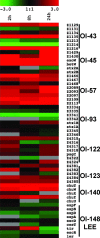Escherichia coli O157:H7 survives within human macrophages: global gene expression profile and involvement of the Shiga toxins
- PMID: 18725421
- PMCID: PMC2573336
- DOI: 10.1128/IAI.00446-08
Escherichia coli O157:H7 survives within human macrophages: global gene expression profile and involvement of the Shiga toxins
Abstract
Escherichia coli O157:H7 is an important food-borne pathogen that specifically binds to the follicle-associated epithelium in the intestine, which rapidly brings this bacterial pathogen in contact with underlying human macrophages. Very little information is available about the interaction between E. coli O157:H7 and human macrophages. We evaluated the uptake and survival of strain EDL933 during infection of human macrophages. Surprisingly, EDL933 survived and multiplied in human macrophages at 24 h postinfection. The global gene expression profile of this pathogen during macrophage infection was determined. Inside human macrophages, upregulation of E. coli O157:H7 genes carried on O islands (such as pagC, the genes for both of the Shiga toxins, and the two iron transport system operons fit and chu) was observed. Genes involved in acid resistance and in the SOS response were upregulated. However, genes of the locus of enterocyte effacement or genes involved in peroxide resistance were not differentially expressed. Many genes with putative or unknown functions were upregulated inside human macrophages and may be newly discovered virulence factors. As the Shiga toxin genes were upregulated in macrophages, survival and cytotoxicity assays were performed with isogenic Shiga toxin mutants. The initial uptake of Shiga toxins mutants was higher than that of the wild type; however, the survival rates were significantly lower at 24 h postinfection. Thus, Shiga toxins are implicated in the interaction between E. coli O157:H7 and human macrophages. Understanding the molecular mechanisms used by E. coli to survive within macrophages may help in the identification of targets for new therapeutic agents.
Figures







Similar articles
-
Differences in adherence and virulence gene expression between two outbreak strains of enterohaemorrhagic Escherichia coli O157 : H7.Microbiology (Reading). 2010 Feb;156(Pt 2):408-419. doi: 10.1099/mic.0.033126-0. Epub 2009 Nov 5. Microbiology (Reading). 2010. PMID: 19892762 Free PMC article.
-
Global transcriptional response of Escherichia coli O157:H7 to growth transitions in glucose minimal medium.BMC Microbiol. 2007 Oct 29;7:97. doi: 10.1186/1471-2180-7-97. BMC Microbiol. 2007. PMID: 17967175 Free PMC article.
-
Decrease in Shiga toxin expression using a minimal inhibitory concentration of rifampicin followed by bactericidal gentamicin treatment enhances survival of Escherichia coli O157:H7-infected BALB/c mice.Ann Clin Microbiol Antimicrob. 2011 Sep 12;10:34. doi: 10.1186/1476-0711-10-34. Ann Clin Microbiol Antimicrob. 2011. PMID: 21906403 Free PMC article.
-
A brief overview of Escherichia coli O157:H7 and its plasmid O157.J Microbiol Biotechnol. 2010 Jan;20(1):5-14. J Microbiol Biotechnol. 2010. PMID: 20134227 Free PMC article. Review.
-
The locus of enterocyte effacement pathogenicity island of Shiga toxin-producing Escherichia coli O157:H7 and other attaching and effacing E. coli.Jpn J Med Sci Biol. 1998;51 Suppl:S101-7. doi: 10.7883/yoken1952.51.supplement1_s101. Jpn J Med Sci Biol. 1998. PMID: 10211442 Review. No abstract available.
Cited by
-
Legionella Pneumophila Transcriptome during Intracellular Multiplication in Human Macrophages.Front Microbiol. 2011 Apr 4;2:60. doi: 10.3389/fmicb.2011.00060. eCollection 2011. Front Microbiol. 2011. PMID: 21747786 Free PMC article.
-
Virulence-related O islands in enterohemorrhagic Escherichia coli O157:H7.Gut Microbes. 2021 Jan-Dec;13(1):1992237. doi: 10.1080/19490976.2021.1992237. Gut Microbes. 2021. PMID: 34711138 Free PMC article.
-
17(R)-Resolvin D1 differentially regulates TLR4-mediated responses of primary human macrophages to purified LPS and live E. coli.J Leukoc Biol. 2011 Sep;90(3):459-70. doi: 10.1189/jlb.0311145. Epub 2011 Jun 7. J Leukoc Biol. 2011. PMID: 21653234 Free PMC article.
-
The gluconeogenesis pathway is involved in maintenance of enterohaemorrhagic Escherichia coli O157:H7 in bovine intestinal content.PLoS One. 2014 Jun 2;9(6):e98367. doi: 10.1371/journal.pone.0098367. eCollection 2014. PLoS One. 2014. PMID: 24887187 Free PMC article.
-
Proteomic View of Interactions of Shiga Toxin-Producing Escherichia coli with the Intestinal Environment in Gnotobiotic Piglets.PLoS One. 2013 Jun 19;8(6):e66462. doi: 10.1371/journal.pone.0066462. Print 2013. PLoS One. 2013. PMID: 23840478 Free PMC article.
References
-
- Baldassarri, L., L. Bertuccini, R. Creti, P. Filippini, M. G. Ammendolia, S. Koch, J. Huebner, and G. Orefici. 2005. Glycosaminoglycans mediate invasion and survival of Enterococcus faecalis into macrophages. J. Infect. Dis. 1911253-1262. - PubMed
-
- Baltes, N., F. F. Buettner, and G. F. Gerlach. 2007. Selective capture of transcribed sequences (SCOTS) of Actinobacillus pleuropneumoniae in the chronic stage of disease reveals an HlyX-regulated autotransporter protein. Vet. Microbiol. 123110-121. - PubMed
Publication types
MeSH terms
Substances
Associated data
- Actions
LinkOut - more resources
Full Text Sources
Medical
Molecular Biology Databases
Research Materials

